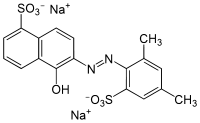Scarlet GN
 | |
| Names | |
|---|---|
| Systematic IUPAC name
Disodium 3-[(2,4-Dimethyl-5-sulfonatophenyl)hydrazinylidene]-4-oxonaphthalene-1-sulfonate | |
| Other names
Crimson 4R; C.I. Food Red 1; Food red 1; FD & C Red no. 4; Hexacol Ponceau SX; Maple Ponceau SX; Ponceau SX; Purple 4R; E125 | |
| Identifiers | |
| 4548-53-2 (Z) | |
| ChemSpider | 5020702 (Z) |
| EC number | 221-856-3 |
| |
| Jmol-3D images | Image Image |
| PubChem | 6537642 (Z) 5483118 (E) |
| |
| UNII | X3W0AM1JLX |
| Properties | |
| Molecular formula |
C18H14N2Na2O7S2 |
| Molar mass | 480.42 g·mol−1 |
| Except where noted otherwise, data is given for materials in their standard state (at 25 °C (77 °F), 100 kPa) | |
| | |
| Infobox references | |
Scarlet GN, or C.I. Food Red 1, Ponceau SX, FD&C Red No. 4, or C.I. 14700 is a red azo dye once used as a food dye. As a food additive, it has the E number E125. It usually used as a disodium salt.
In the United States, it is not permitted as a food additive and may only be used in externally applied drugs and cosmetics.[1][2][3] An exception was added to allow the coloring of maraschino cherries, which then are considered mainly decorative and not a foodstuff.[4] In the European Union, it is not permitted as a food additive.[5]
References
- ↑ 21 C.F.R. 81.10
- ↑ 21 C.F.R. 81.30
- ↑ 21 C.F.R. 82.304
- ↑ Pavia, Donald L. (2005). Introduction to Organic Laboratory Techniques: A Small Scale Approach (2nd ed.). Retrieved January 25, 2013.
- ↑ Current EU approved additives and their E Numbers, Food Standards Agency